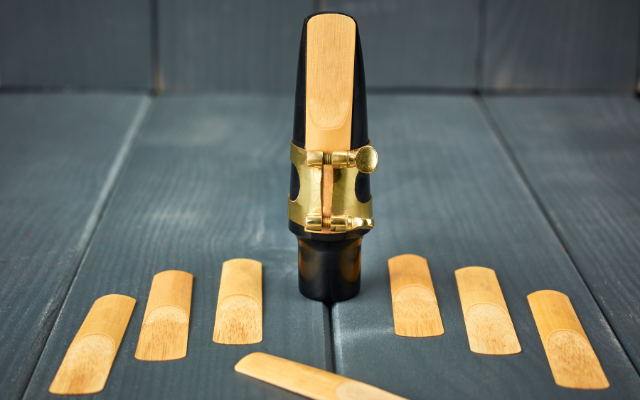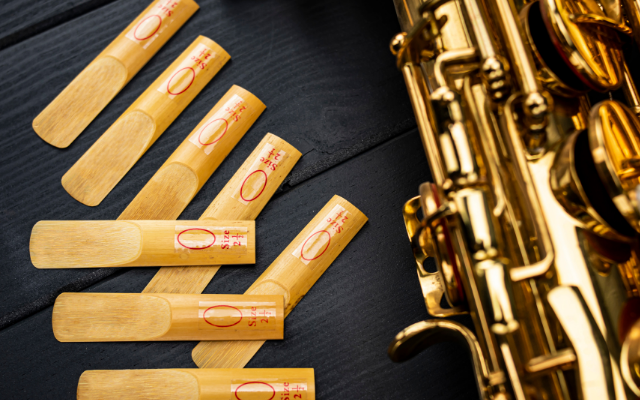Some believe that playing on a hard reed strength shows you are a better player. This isn’t necessarily the case. Just like shoes, you need to find the size that fits you. An important question to ask is when you should change reed strength.
A saxophonist may find it’s time to change reed strength at any time. Recognize the signs. Move up if it’s hard to get a warm sound on the high notes or the pitch is flat. Move down if the sound is stuffy and articulation isn’t clean. Reed strength needs to match the mouthpiece you’re playing on.
Below, we discuss the difference between reed size and reed strength, the benefits of moving to a harder reed, how to know when it’s time to change reed strength, and the importance of breaking in reeds.
Table of Contents
How do you know you need a higher strength reed?
When a beginner starts out, they are usually given a 2 or a 2½ strength reed. This is a fairly soft reed which will respond easily for someone who hasn’t developed their embouchure much yet.
As they progress and their embouchure starts to strengthen, the student may find the following problems with their playing:
- Sound is produced with very little muscle power in the embouchure. In fact, using the correct embouchure may cause the reed to close up against the mouthpiece
- Sound is too bright and edgy
- Pitch is difficult to control. Notes may scoop or waver in pitch
- Pitch is flat overall
- It’s difficult to play loud
- High notes won’t respond well
These are signs that it is time to move up a reed strength. They are an indication that the student is progressing on the instrument.
As stated above, though, this need to move up a reed size doesn’t continue indefinitely.
Sometimes the mouthpiece is the problem. If you’ve been playing on a beginner mouthpiece, it may be time to move up to a better piece of equipment.
This will often be a mouthpiece which is more open and provides a warmer, more rounded sound.
A good way to test reed strength with your mouthpiece setup is to check your highest and lowest note. You should be able to get a good sound when playing a low Bb very soft and a high F# very loud.
Why is reed size important?

Reed size vs reed strength
Reed size determines what instrument the reed is made for. A reed that is sized for an Eb clarinet will not work on a tenor saxophone mouthpiece, for example. When purchasing reeds, be sure to get reeds which are sized for your instrument.
However, the term “size” is often used in place of “strength”. Reed strength refers to the thickness of the reed. This relates to how much effort it takes to produce a sound.
Usually, reeds are numbered by their strength. A reed that is labelled strength 2 is thinner and will vibrate more easily than a reed that is labelled strength 4. Some manufacturers label their reeds soft (thin), medium and hard (thick).
The harder a reed, the more effort it takes to make it vibrate against the mouthpiece. This means the player needs more muscle power in their embouchure (how you use the muscles of your mouth to play a wind instrument) to play.
Reed and mouthpiece partnership
Your mouthpiece plays an important part in helping you decide what strength reed to play on. If it is close – the tip of the reed sits close to the tip of the mouthpiece, you will generally need a slightly harder reed.
For a mouthpiece which is open (the tip of the reed is a little farther from the tip of the mouthpiece), a slightly softer reed will often work best.
When taking into consideration the closeness of the mouthpiece and the strength of the reed, most players average medium. Some players, however, play best with a little more resistance than average, some a little less.
Reed cut vs size
Different brands and styles of reeds are cut differently, regardless of the reed size. They may look the same, but the thickness of the heel, shape of the vamp and the tip thickness can be very different.
For example, Vandoren reeds (blue box) have the thinnest heel of all of the different styles of Vandoren reeds. They have a filed cut, producing a warmer, rounder sound. They have a thin tip and a thicker heart to produce a vibrant but round sound.
The Vandoren V16 reeds are a favorite for jazz saxophonists. They are unfiled, providing a brighter, edgier sound. They also have a thicker tip, which gives brilliance to the tone.
What do you gain from a higher strength (size) reed?

There are a number of benefits to moving up a strength (or ½ strength) in reed, if you determine it’s necessary.
Overall, a harder reed can produce a fuller, rounder sound. It will take away some of the edginess or brightness to your tone. It will also bring your pitch up if you tend to play flat.
Higher notes are often easier to play with a harder reed. The reed vibrates faster the higher you play, so the high notes require a certain amount of stiffness to the reed so that it doesn’t close up against the mouthpiece.
A harder reed will give high notes a warmer sound that matches your other registers better.
Cons of a higher reed size
If you play on a reed that is too hard for your mouthpiece setup, your note may sound dull. The low notes won’t respond as easily and they may sound fuzzy. Articulation won’t be as clean and you’ll most likely play sharp.
Once you get to a 3 or a 3½ reed, you may not need to go higher. As mentioned above, it’s about finding the right match for you and your mouthpiece.
Note that just because someone plays on a 4½ reed doesn’t mean they’re a more advanced player.
Are there situations where you should go down in size?
You may find yourself in a situation where you’re playing on reeds that are too hard.
Are you having to work very hard to get a sound to come out? Are the notes fuzzy, especially in the lower register? Is it difficult to articulate cleanly? Or are you playing sharp consistently?
If these problems sound familiar, you may be playing on a reed which is too hard. Try going down a half strength. You may find it much more comfortable to play and you’ll produce a better sound.
Another time to consider reed strength is if you change the brand or style of reed you’re playing on. A 3 strength reed for one type of reed may be like a 3½ strength reed on another.
Or you may prefer to get an easier response when playing jazz, so you need to go down in strength
Balancing and breaking in reeds vs changing size
As you progress, it’s important to learn how to balance and break in your reeds. This helps to ensure that your reeds play well more consistently without changing size, and that they last longer.
If you put a reed on your mouthpiece right out of the box, it may seem too hard and fuzzy. It may even be worse the second day. This doesn’t necessarily mean the reed strength is too hard for you.
Try starting out by playing on the reed for only a minute or two, gradually playing for longer each day during the first week. After breaking it in gradually, you may find it’s the perfect strength.
Learn more about breaking in a clarinet reed.
Recap: when to move up a reed size
It’s important to know the signs that it’s time to try a different reed strength. If it takes too little embouchure effort to make a sound and the tone is edgy and bright, try a harder strength reed.
If it takes too much embouchure effort and the tone is fuzzy and dull, try a softer strength reed. Remember that all of this works in combination with your mouthpiece.
The different reed brands and styles don’t match in reed strength. If you change the type of reeds you’re playing on, you may need to go up or down in strength.
How to find the perfect reed is a question probably every saxophone player has asked at one time or another. Finding the right reed in combination with your mouthpiece is an ongoing process of trial and error.
Learn to break in your reeds for better consistency and durability. This can make a reed which seems to be the wrong strength turn out to be the right one for you.

